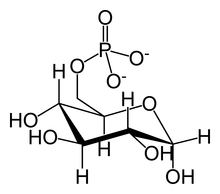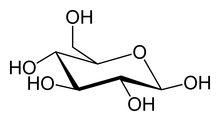Glucose 6-phosphatase


Glucose 6-phosphatase (Glc-6-Pase) is an enzyme that hydrolyzes glucose-6-phosphate resulting in the creation of a phosphate group and free glucose. Glucose is then exported from the cell via glucose transporter membrane proteins (Ghosh 2002). This catalysis completes the final step in gluconeogenesis and glycogenolysis and therefore plays a key role in the homeostatic regulation of blood glucose levels (Nordlie 1985).
The Glc-6-Pase family includes two functional phosphohydrolases; Glc-6-Pase-α and Glc-6-Pase-β, the former of which is the prototype. Glc-6-Pase-α and Glc-6-Pase-β share similar active site structure, topology, mechanism of action, and kinetic properties with respect to Glc-6-P hydrolysis (Ghosh 2004).
Structure and Function
Although a clear consensus has not been reached, a large number of scientists adhere to a substrate-transport model to account for the catalytic properties of glucose-6-Pase. In this model, glucose 6-Pase has a low degree of selectivity. The transfer of the glucose 6 phosphate is carried out by a transporter protein (T1) and the endoplasmic reticulum (ER) contains structures allowing the exit of the phosphate group (T2) and glucose (T3) (Schaftingen 2002).
Glucose-6-Pase consists of 357 amino acids, and is anchored to the endoplasmic reticulum (ER) by nine transmembrane helicies. Its N-terminal and active site are found on the lumen side of the ER and its C-terminus projects into the cytoplasm. Due to its tight association to the ER, the exact structure of glucose-6-Pase remains unknown. However, sequence alignment has shown that glucose-6-Pase is structurally similar to the active site of the vanadium-containing chloroperoxidase found in Curvularia inaequalis (Pan 1997).
Based on pH kinetic studies of Glc-6-Pase-α catalysis, it was proposed that the hydrolysis of Glucose-6-Phosphate was completed via a covalent phosphohistidine glucose-6-Phosphate intermediate. The active site of Glc-6-Pase-α was initially identified by the presence of a conserved phosphate signature motif usually found in lipid phosphatases, acid phosphatases, and vanadium haloperoxidases (Ghosh 2004).
Essential residues in the active site of vanadium haloperoxidases include: Lys353, Arg360, His404, and His496. Corresponding residues in the active site of Glc-6-Pase-α include Arg170 and Arg83, which donate hydrogen ions to the phosphate to stabilize the transition state, His119, which provides a proton to the dephosphorylated oxygen attached to glucose, and His176, which completes a nucleophilic attack on the phosphate to form a covalently bound phosphoryl enzyme intermediate (Ghosh 2002). Within the Vanadium-containing chloroperoxidase, Lys353 was found to stabilize the phosphate in the transition state. However, the corresponding residue in Glc-6-Pase-α resides within the ER membrane and its function, if any, is currently undetermined. With the exception of Lys76, these residues are all located on the luminal side of the ER membrane (Ghosh 2004).
Glc-6-Pase-β is a ubiquitously expressed, 346-amino acid membrane protein that shares 36% sequence identity with Glc-6-Pase-α. Within the Glc-6-Pase-β enzyme, sequence alignments predict that its active site contains His167, His114, and Arg79. Similar to that of the Glc-6-Pase-α active site, His167 is the residue that provides the nucleophilic attack, and His114, and Arg79 are the hydrogen donors. Glc-6-Pase-β is also localized in the ER membrane, although its orientation is unknown (Ghosh 2004).
Mechanism
The hydrolysis of the Glc-6-P begins with a nucleophilic attack on the sugar-bound phosphate by His176 resulting in the formation of a phosphohistidine bond and the degredation of a carbonyl. A Negatively charged oxygen then transfers its electrons reforming a carbonyl and breaking its bond with glucose. The negatively charged glucose-bound oxygen is then protonated by His119 forming a free glucose. The phospho-intermediate produced by the reaction between His176 and the phosphate group is then broken by a hydrophilic attack; after the addition of another hydroxide and the decomposition of a carbonyl, the carbonyl is reformed kicking off the electrons originally donated by the His176 residue thereby creating a free phosphate group and completing the hydrolysis. (Ghosh 2002)
Expression
Genes coding for the enzyme are primarily expressed in the liver and kidney cortex and to a lesser extent the b-cells of the pancreatic islets and intestinal mucosa (esp. during times of starvation (Schaftingen 2002). According to Surholt and Newsholme, Glc 6-Pase is present in a wide variety of muscles across the animal kingdom, albeit at very low concentrations. [1]. The enzyme plays and important role during periods of fasting and when glucose levels are low. It has been shown that starvation and diabetes induces a 2-3-fold increase in Glc-6-Pase activity in the liver (Schaftingen 2002). Glc 6-Pase activity also increases dramatically at birth when an organism becomes independent of the mothers source of glucose. The human Glc 6-Pase gene contains five exons spanning approximately 125.5 kb DNA located on chromosome 17q21 (Angaroni 2004).
Clinical Significance
Mutations in Glc-6-Pase-α can lead to the glycogen storage disease type 1a called von Gierke's disease, which is characterized by loss of blood glucose homeostasis and disorders of glycogen and lipid metabolism.
See also
References
* Ghosh, A., et al. (2002). The Catalytic Center of Glucose-6-phosphatase. J. Biol. Chem. vol 227 pg 32837-32842
* Angaroni, C., et al. (2004). Glycogen storage disease type 1a in Argentina: two novel glucose-6-phosphatase mutations affection protein stability. Molecular Genetics and Metabolism. vol 83 pg 276-279
* Ghosh, A., et al. (2004). Histidine 167 Is the Phosphate Acceptor in Glucose-6-phosphatase-Beta Forming a Phosphohistidine Enzyme Intermediate during Catalysis. J. Biol. Chem. vol 279 pg 12479-12483
* Schaftingen, E., et al. (2004). The Glucose-6-phosphatase System. Biochem. J. vol 362 pg 513-532
* Pan, C., et al. (1997). Transmembrane Topology of Glucose-6-phosphatase. Biochem. J. vol 273 pg 6144-6148
* Nordlie, R., et al. (1985). The Enzymes of Biological Membranes. (Martonosi, A.N.,ed), 2nd Ed., pg 349-398 Plenum Press, New York
External links
- Glucose-6-Phosphatase at the U.S. National Library of Medicine Medical Subject Headings (MeSH)
- G6PC, G6PC2, G6PC3, G6PR
- . GPnotebook https://www.gpnotebook.co.uk/simplepage.cfm?ID=2134179898.
{{cite web}}: Missing or empty|title=(help) - EC 3.1.3.9
